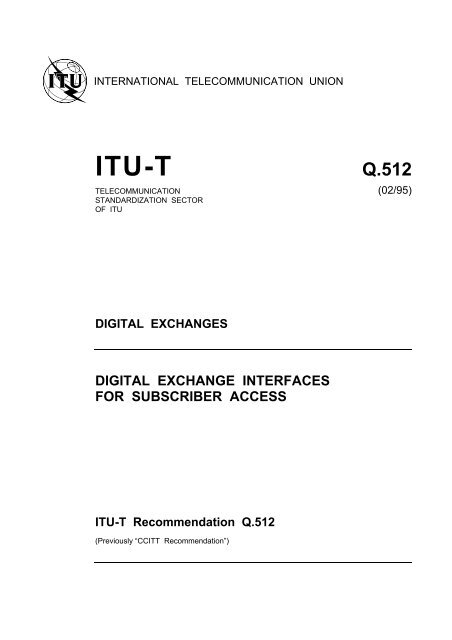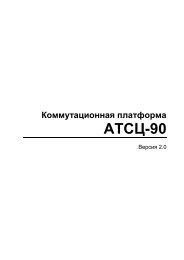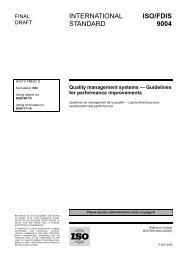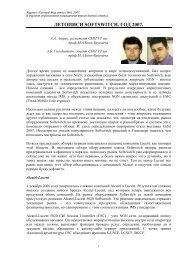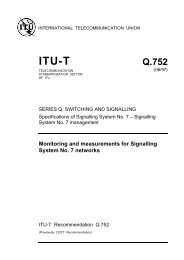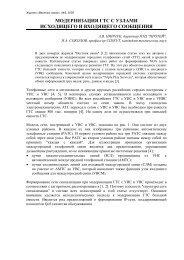digital exchange interfaces for subscriber access
digital exchange interfaces for subscriber access
digital exchange interfaces for subscriber access
You also want an ePaper? Increase the reach of your titles
YUMPU automatically turns print PDFs into web optimized ePapers that Google loves.
INTERNATIONAL TELECOMMUNICATION UNION<br />
ITU-T Q.512<br />
TELECOMMUNICATION (02/95)<br />
STANDARDIZATION SECTOR<br />
OF ITU<br />
DIGITAL EXCHANGES<br />
DIGITAL EXCHANGE INTERFACES<br />
FOR SUBSCRIBER ACCESS<br />
ITU-T Recommendation Q.512<br />
(Previously “CCITT Recommendation”)
FOREWORD<br />
The ITU-T (Telecommunication Standardization Sector) is a permanent organ of the International Telecommunication<br />
Union (ITU). The ITU-T is responsible <strong>for</strong> studying technical, operating and tariff questions and issuing Recommendations<br />
on them with a view to standardizing telecommunications on a worldwide basis.<br />
The World Telecommunication Standardization Conference (WTSC), which meets every four years, establishes the<br />
topics <strong>for</strong> study by the ITU-T Study Groups which, in their turn, produce Recommendations on these topics.<br />
The approval of Recommendations by the Members of the ITU-T is covered by the procedure laid down in WTSC<br />
Resolution No. 1 (Helsinki, March 1-12, 1993).<br />
ITU-T Recommendation Q.512 was revised by ITU-T Study Group 11 (1993-1996) and was approved under the WTSC<br />
Resolution No. 1 procedure on the 7th of February 1995.<br />
___________________<br />
NOTE<br />
In this Recommendation, the expression “Administration” is used <strong>for</strong> conciseness to indicate both a telecommunication<br />
administration and a recognized operating agency.<br />
© ITU 1995<br />
All rights reserved. No part of this publication may be reproduced or utilized in any <strong>for</strong>m or by any means, electronic or<br />
mechanical, including photocopying and microfilm, without permission in writing from the ITU.
Recommendation Q.512 (02/95)<br />
CONTENTS<br />
Page<br />
1 Scope.............................................................................................................................................................. 1<br />
2 References...................................................................................................................................................... 1<br />
3 Terms and definitions..................................................................................................................................... 3<br />
4 Abbreviations ................................................................................................................................................. 4<br />
5 Characteristics of <strong>digital</strong> <strong>interfaces</strong> <strong>for</strong> <strong>subscriber</strong> <strong>access</strong>.............................................................................. 4<br />
5.1 General.............................................................................................................................................. 4<br />
5.2 Interface V 1 ....................................................................................................................................... 4<br />
5.2.1 General ............................................................................................................................ 4<br />
5.2.2 Functional characteristics.................................................................................................. 4<br />
5.2.3 Electrical characteristics.................................................................................................... 5<br />
5.2.4 Channel types, channel allocation and signalling ............................................................. 5<br />
5.3 Interface V 2 ....................................................................................................................................... 6<br />
5.3.1 General ............................................................................................................................ 6<br />
5.3.2 Functional characteristics.................................................................................................. 6<br />
5.3.3 Electrical characteristics.................................................................................................... 6<br />
5.3.4 Channel types, channel allocation and signalling ............................................................. 6<br />
5.4 Interface V 3 ....................................................................................................................................... 6<br />
5.4.1 General ............................................................................................................................ 6<br />
5.4.2 Functional characteristics.................................................................................................. 6<br />
5.4.3 Electrical characteristics.................................................................................................... 6<br />
5.4.4 Channel types, channel allocation and signalling ............................................................. 6<br />
5.5 Interface V 4 ....................................................................................................................................... 7<br />
5.6 Interface V 5 ....................................................................................................................................... 7<br />
5.6.1 General ............................................................................................................................ 7<br />
5.6.2 Functional characteristics.................................................................................................. 7<br />
5.6.3 Electrical characteristics.................................................................................................... 9<br />
5.6.4 Channel types, channel allocation and signalling ............................................................. 9<br />
6 Characteristics of analogue <strong>interfaces</strong> <strong>for</strong> <strong>subscriber</strong> <strong>access</strong>.......................................................................... 9<br />
6.1 Interface Z......................................................................................................................................... 9<br />
Appendix I – Bibliography...................................................................................................................................... 10<br />
Recommendation Q.512 (02/95) i
SUMMARY<br />
This Recommendation describes the <strong>subscriber</strong> side interface characteristics of <strong>digital</strong> <strong>exchange</strong>s. It applies to <strong>digital</strong><br />
local and combined <strong>exchange</strong>s <strong>for</strong> telephony in Integrated Digital Networks (IDN) and to local and combined <strong>exchange</strong>s<br />
in an Integrated Services Digital Network (ISDN), and also to mixed (analogue/<strong>digital</strong>) networks.<br />
This Recommendation is part of the Q.510-Series of Recommendations which defines the interface functions <strong>for</strong> <strong>digital</strong><br />
<strong>exchange</strong>s in Integrated Digital Networks (IDN), mixed analogue/<strong>digital</strong> networks, 64 kbit/s-based Integrated Services<br />
Digital Network (ISDN).<br />
BACKGROUND<br />
Preamble to the Q.500-Series of Recommendations<br />
In 1980, CCITT Study Group XI published the first series of Q.500 Recommendations related to “Digital transit<br />
<strong>exchange</strong>s <strong>for</strong> national and international applications”.<br />
In 1984, CCITT Study Group XI approved two sets of Recommendations on <strong>digital</strong> <strong>exchange</strong>s:<br />
– “Digital transit <strong>exchange</strong>s in integrated <strong>digital</strong> networks and mixed analogue/<strong>digital</strong> networks” –<br />
Q.500-Series of Recommendations; and<br />
– “Digital local and combined <strong>exchange</strong>s” – Q.510-Series of Recommendations.<br />
In 1988, CCITT Study Group XI combined the Series Q.500 and Q.510 Recommendations into a single set applicable to<br />
<strong>digital</strong> local, combined, transit and international <strong>exchange</strong>s in Integrated Digital Networks (IDN) and mixed analogue<strong>digital</strong><br />
networks, and also to local, combined, transit and international <strong>exchange</strong>s in an Integrated Services Digital<br />
Network (ISDN).<br />
In 1994, ITU-T Study Group 11 revised the Q.500-Series of Recommendations in order to include a new <strong>exchange</strong><br />
interface <strong>for</strong> <strong>subscriber</strong> <strong>access</strong> – the V 5 interface (i.e. the V 5.1 interface). The V 3 interface is to the case of an ISDN<br />
primary rate <strong>access</strong> and the case that this interface is used not structured according to the ISDN principles is considered<br />
as not subject to ITU-T Recommendations. The V 4 interface is marked as not subject to ITU-T Recommendations;<br />
reference should be made to interface V 5.1 which covers static multiplexed ISDN basic <strong>access</strong>es. The V 4 interface was a<br />
<strong>digital</strong> interface used to connect a <strong>digital</strong> <strong>access</strong> link which includes a static multiplexer supporting several basic <strong>access</strong><br />
<strong>digital</strong> sections. For this interface, the specification (i.e. CV 1 channel structure) was not completed.<br />
ITU-T will continue to further develop and complete these Recommendations in areas where there are unresolved issues<br />
and develop additional Recommendations on <strong>digital</strong> <strong>exchange</strong>s in the Q.500-Series and other series in the future.<br />
The structure <strong>for</strong> the Q.500-Series of <strong>digital</strong> switching Recommendations is provided in Recommendation Q.500.<br />
ii Recommendation Q.512 (02/95)
Recommendation Q.512<br />
Recommendation Q.512 (02/95)<br />
DIGITAL EXCHANGE INTERFACES<br />
FOR SUBSCRIBER ACCESS<br />
(Melbourne, 1988; revised in 1994)<br />
1 Scope<br />
It applies to <strong>digital</strong> local and combined <strong>exchange</strong>s <strong>for</strong> telephony in Integrated Digital Networks (IDN) and to local and<br />
combined <strong>exchange</strong>s in an Integrated Services Digital Network (ISDN), and also to mixed (analogue/<strong>digital</strong>) networks.<br />
The field of application of this Recommendation is more fully defined in Recommendation Q.500 [B6].<br />
Exchange <strong>interfaces</strong> <strong>for</strong> <strong>subscriber</strong> <strong>access</strong> that have been considered are described, and illustrated in Figure 1 and<br />
Table 1, but they are not intended to specify every interface. Other <strong>interfaces</strong> are <strong>for</strong> further study.<br />
This Recommendation is not intended to define any transmission system, network or <strong>subscriber</strong> equipment in or<br />
connected to, a <strong>digital</strong> <strong>exchange</strong> via these <strong>interfaces</strong>. There<strong>for</strong>e only the characteristics of the <strong>interfaces</strong> are described.<br />
2 References<br />
The following Recommendations and other references contain provisions which, through reference in this text, constitute<br />
provisions of this Recommendation. At the time of publication, the editions indicated were valid. All Recommendations<br />
and other references are subject to revision: all users of this Recommendation are there<strong>for</strong>e encouraged to investigate the<br />
possibility of applying the most recent edition of the Recommendations and other references listed below. A list of the<br />
currently valid ITU-T Recommendations is regularly published.<br />
[1] CCITT Recommendation G.703 (1991), Physical/electrical characteristics of hierarchical <strong>digital</strong> <strong>interfaces</strong>.<br />
[2] CCITT Recommendation G.704 (1991), Synchronous frame structures used at primary and secondary<br />
hierarchical levels.<br />
[3] CCITT Recommendation G.706 (1991), Frame alignment and Cyclic Redundancy Check (CRC) procedures<br />
relating to basic frame structures defined in Recommendation G.704.<br />
[4] ITU-T Recommendation G.960 (1993), Digital section <strong>for</strong> ISDN basic rate <strong>access</strong>.<br />
[5] ITU-T Recommendation G.961 (1993), Digital transmission system on metallic local lines <strong>for</strong> ISDN basic rate<br />
<strong>access</strong>.<br />
[6] ITU-T Recommendation G.962 (1993), Access <strong>digital</strong> section <strong>for</strong> ISDN primary rate at 2048 kbit/s.<br />
[7] ITU-T Recommendation G.963 (1993), Access <strong>digital</strong> section <strong>for</strong> ISDN primary rate at 1544 kbit/s.<br />
[8] ITU-T Recommendation G.964 (1994), V Interfaces at the <strong>digital</strong> Local Exchange (LE) – V 5.1 interface (based on<br />
2048 kbit/s) <strong>for</strong> the support of Access Network (AN).<br />
[9] ITU-T Recommendation G.965 (1995), V <strong>interfaces</strong> at the <strong>digital</strong> Local Exchange (LE) – V 5.2 interface (based on<br />
2048 kbit/s) <strong>for</strong> the support of Access Network (AN).<br />
[10] CCITT Recommendation M.3603 (1992), Application of maintenance principles to ISDN basic rate <strong>access</strong>.<br />
[11] CCITT Recommendation M.3604 (1992), Application of maintenance principles to ISDN primary rate <strong>access</strong>.<br />
[12] CCITT Recommendation M.3605 (1992), Application of maintenance principles to static multiplexed ISDN rate<br />
<strong>access</strong>.<br />
Recommendation Q.512 (02/95) 1
T<br />
Basic <strong>access</strong> <strong>digital</strong> section<br />
V 1<br />
(See b) )<br />
ET<br />
a)<br />
V 2<br />
V 3<br />
Generic <strong>digital</strong> section<br />
V 2<br />
ET<br />
c)<br />
T<br />
Primary rate <strong>access</strong> <strong>digital</strong> section<br />
ET<br />
c)<br />
T<br />
1<br />
d)<br />
Digital <strong>access</strong> link (static multiplex)<br />
V 4<br />
T<br />
. . . . .<br />
n<br />
c)<br />
ET<br />
Z<br />
Access line configuration<br />
(static multiplexing and/or concentration)<br />
T<br />
V 5<br />
ET<br />
e)<br />
c)<br />
Leased line<br />
port f)<br />
Subscriber analogue line (2-wire)<br />
Z<br />
ET<br />
T1171350-95/d01<br />
Interface Reference point ET Exchange Termination functions<br />
a) Interface T is defined in Recommendation I.411.<br />
b)<br />
The characteristics of a <strong>digital</strong> transmission system on metallic local lines <strong>for</strong> ISDN basic rate <strong>access</strong> which may<br />
<strong>for</strong>m part of the basic <strong>access</strong> <strong>digital</strong> section are defined in Recommendation G.961.<br />
c)<br />
The differences among V 2, V 3, V 4and V 5 are essential multiplexing and signalling requirements. The transmission<br />
requirements are substantially identical (e.g. Recommendations G.703 and G.704).<br />
d)<br />
See in<strong>for</strong>mation provided in "Background".<br />
e)<br />
May be basic rate or primary rate <strong>access</strong>. Primary rate <strong>access</strong> only supported by V 5.2 interface.<br />
f)<br />
For reserved connections established under control of the local <strong>exchange</strong> without control plane signalling between<br />
user and local <strong>exchange</strong>.<br />
NOTE – Not all <strong>interfaces</strong> will necessarily exist in every implementation.<br />
FIGURE 1/Q.512<br />
Illustration of possible <strong>access</strong> configurations<br />
FIGURE 1/Q.512...[D01] = 21 cm<br />
2 Recommendation Q.512 (02/95)
TABLE 1/Q.512<br />
Interface references<br />
Access type<br />
Interface/<br />
reference<br />
points<br />
Paragraph<br />
Related physical and<br />
functional Recs.<br />
Related OAM Recs.<br />
Application<br />
to connect<br />
Basic <strong>access</strong> <strong>digital</strong><br />
section<br />
Generic <strong>digital</strong><br />
section<br />
V 1 5.2 G.960 a) M.3603 ISDN basic <strong>access</strong><br />
(2B + D)<br />
V 2 5.3 G.703 G.704 None Digital network<br />
equipment,<br />
supporting any<br />
combination of<br />
<strong>access</strong> types<br />
Primary rate <strong>access</strong><br />
<strong>digital</strong> section b)<br />
V 3 5.4 G.703<br />
G.704<br />
G.706<br />
G.962<br />
G.963<br />
M.3604 ISDN primary rate<br />
<strong>access</strong><br />
Digital <strong>access</strong> link<br />
(Static multiplex)<br />
V 4 5.5 Not subject to ITU-T Recommendations c)<br />
Access network<br />
configurations<br />
V 5 5.6 G.703<br />
G.704<br />
G.706<br />
G.964<br />
G.965<br />
M.3603 d)<br />
M.3604 d)<br />
A multiple of<br />
analogue <strong>subscriber</strong><br />
lines, ISDN basic<br />
<strong>access</strong>es and ISDN<br />
primary rate<br />
<strong>access</strong>es with<br />
multiplexing and/or<br />
concentration<br />
capability <strong>for</strong> bearer<br />
channels<br />
Generic analogue<br />
<strong>subscriber</strong> <strong>access</strong><br />
Z 6.1 None e) None Analogue <strong>subscriber</strong><br />
lines<br />
a) Recommendation G.961 specifies the characteristics of a <strong>digital</strong> transmission system on metallic local lines which may<br />
<strong>for</strong>m part of the basic <strong>access</strong> <strong>digital</strong> section.<br />
b) In the case of ISDN <strong>access</strong> this is the primary rate <strong>access</strong> <strong>digital</strong> section.<br />
c) See in<strong>for</strong>mation in “Background”.<br />
d) For ISDN application through the V 5 <strong>interfaces</strong>.<br />
e) Characteristics other than those defined in Recommendations Q.551 and Q.552 are not subject to ITU-T Recommendations.<br />
3 Terms and definitions<br />
For the purposes of this Recommendation, the following definitions apply:<br />
3.1 <strong>digital</strong> section: A <strong>digital</strong> section is defined as the whole of the means of <strong>digital</strong> transmission of a <strong>digital</strong> signal<br />
of specified rate between two consecutive reference points. A <strong>digital</strong> link comprises one or more <strong>digital</strong> sections and<br />
may include either a multiplexer or concentrator, but not switching.<br />
3.2 <strong>access</strong> <strong>digital</strong> section: The functional requirements to transmit the in<strong>for</strong>mation from/to the user-network<br />
interface and to transmit, multiplex, demultiplex and process in<strong>for</strong>mation required <strong>for</strong> operation and maintenance from/to<br />
the associated V-reference point related to that particular user-network interface. This excludes the extraction,<br />
concentration and multiplexing/demultiplexing of channels with hierarchies other than the one being concerned (as these<br />
are considered by the V-reference point).<br />
Recommendation Q.512 (02/95) 3
In addition, this Recommendation uses terms defined in Recommendations G.962 [6], G.963 [7], G.964 [8], G.965 [9]<br />
and Q.9 [B5].<br />
In this Recommendation the term “<strong>exchange</strong>” or “local <strong>exchange</strong>” is used <strong>for</strong> conciseness to indicate both a (<strong>digital</strong>)<br />
local <strong>exchange</strong> and a (<strong>digital</strong>) combined <strong>exchange</strong>. A (<strong>digital</strong>) combined <strong>exchange</strong> is one which includes both local<br />
<strong>exchange</strong> and transit/toll <strong>exchange</strong> functions.<br />
4 Abbreviations<br />
For the purposes of this Recommendation, the following abbreviations are used:<br />
AN Access Network<br />
CRC Cyclic Redundancy Check<br />
ET Exchange Termination<br />
IDN Integrated Digital Network<br />
ISDN Integrated Services Digital Network<br />
NT1 Network Termination Type 1<br />
PABX Private Automatic Branch Exchange<br />
PCM Pulse code modulation<br />
PSTN Public Switched Telephone Network<br />
5 Characteristics of <strong>digital</strong> <strong>interfaces</strong> <strong>for</strong> <strong>subscriber</strong> <strong>access</strong><br />
5.1 General<br />
Digital <strong>interfaces</strong> <strong>for</strong> <strong>subscriber</strong> <strong>access</strong> are defined at the V-reference point which is the boundary between the Exchange<br />
Termination (ET) and the <strong>digital</strong> <strong>access</strong> section or link. These <strong>interfaces</strong> are designated interface V and are defined to<br />
allow flexibility of implementation <strong>for</strong> different <strong>exchange</strong> and transmission equipment realizations. However, a physical<br />
interface will not be specified <strong>for</strong> all <strong>subscriber</strong> <strong>access</strong> types identified (see Figure 1).<br />
As an objective, the characteristics of <strong>digital</strong> <strong>interfaces</strong> on the <strong>subscriber</strong> side of the <strong>exchange</strong> should be aligned with the<br />
characteristics of ISDN user/network <strong>access</strong> structures (see Recommendation I.411 [B1]).<br />
However, in many countries, <strong>digital</strong> <strong>access</strong> arrangements not structured according to ISDN principles are used, e.g. to<br />
ensure compatibility with existing networks and services and it is expected that these arrangements will continue to be<br />
used <strong>for</strong> several years. These types of <strong>interfaces</strong> not structured according to the ISDN principles are not subject to ITU-T<br />
Recommendations.<br />
5.2 Interface V 1<br />
5.2.1 General<br />
Interface V 1 may be used at the V 1 reference point to connect to an ISDN basic <strong>access</strong> <strong>digital</strong> section <strong>for</strong> the provision of<br />
a single basic <strong>access</strong>. The characteristics of the basic <strong>access</strong> <strong>digital</strong> section are defined in Recommendation G.960 [4]<br />
and the characteristics and parameters of a <strong>digital</strong> transmission system which may <strong>for</strong>m part of the <strong>digital</strong> section <strong>for</strong> the<br />
ISDN basic rate <strong>access</strong> are given in Recommendation G.961 [5].<br />
5.2.2 Functional characteristics<br />
The functional description is illustrated in Figure 2 and the following functional requirements are defined:<br />
1) (2B + D) channels<br />
To provide the bidirectional transmission capability <strong>for</strong> two B-channels and one 16 kbit/s D-channel as<br />
described in Recommendation I.412 [B2].<br />
2) Bit timing<br />
To provide bit (signal element) timing to enable the <strong>digital</strong> section to recover in<strong>for</strong>mation from the<br />
aggregate bit stream.<br />
4 Recommendation Q.512 (02/95)
3) Frame timing<br />
To provide frame timing to enable <strong>digital</strong> section and ET to recover the time division multiplexed<br />
channels.<br />
4) CV 1 channel<br />
The CV 1 channel provides, <strong>for</strong> each direction of transmission, the capability to transfer management<br />
functions required <strong>for</strong> the <strong>digital</strong> section as specified in Recommendations G.960 [4] and M.3603 [10].<br />
The CV 1 channel may carry one or more functional links. These functions include activation from<br />
network side, activation request from a <strong>digital</strong> section, deactivation from ET side, operation and<br />
maintenance signals.<br />
5) Power feed<br />
This function provides <strong>for</strong> remote power feeding <strong>for</strong> the <strong>digital</strong> section and possibly terminal equipment.<br />
This function is optional.<br />
2 B + D-channel<br />
Bit timing<br />
Frame timing<br />
Basic <strong>access</strong><br />
<strong>digital</strong> section<br />
Activationb)<br />
Deactivationb)<br />
Exchange<br />
Termination (ET)<br />
functions<br />
Operation and maintenanceb)<br />
a)<br />
Power feed<br />
a)<br />
The provision of power feed function is optional.<br />
b)<br />
These functions are conveyed by the CV channel.<br />
1<br />
V reference point<br />
1<br />
T1164720-94/d02<br />
FIGURE 2/Q.512<br />
Functions at interface V 1<br />
FIGURE 2/Q.512...[D02] = 10 CM<br />
5.2.3 Electrical characteristics<br />
The electrical characteristics of interface V 1 are not subject to ITU-T Recommendations.<br />
5.2.4 Channel types, channel allocation and signalling<br />
The channel types associated with interface V 1 include two B-channels and one D-channel as defined at the user<br />
network interface in Recommendation I.412 [B2]. In addition, the CV 1 channel is required to support the operational and<br />
maintenance functions.<br />
The channel allocation is not subject to ITU-T Recommendations.<br />
The D-channel signalling procedures are defined in the Q.920 and Q.930-Series Recommendations.<br />
Recommendation Q.512 (02/95) 5
5.3 Interface V 2<br />
5.3.1 General<br />
Interface V 2 is a generic <strong>digital</strong> interface used to connect remote or local <strong>digital</strong> network equipment via a first or second<br />
order <strong>digital</strong> section. This network equipment may support any combination of analogue, <strong>digital</strong> and ISDN <strong>subscriber</strong><br />
<strong>access</strong>. The characteristics of this interface may not be structured according to the ISDN principles.<br />
5.3.2 Functional characteristics<br />
The functional characteristics depend on the specific application of the V 2 interface. These are not generally subject to<br />
ITU-T Recommendations.<br />
5.3.3 Electrical characteristics<br />
The electrical characteristics of interface V 2 are described in Recommendation G.703 [1]. The basic frame structure at<br />
interface V 2 should be identical to that of the first or second order rate multiplexes described in Recommendation<br />
G.704 [2].<br />
5.3.4 Channel types, channel allocation and signalling<br />
The channel types, channel allocation and signalling depend on the specific application of the V 2 interface. These are not<br />
generally subject to ITU-T Recommendations.<br />
5.4 Interface V 3<br />
5.4.1 General<br />
Interface V 3 is a <strong>digital</strong> interface used to connect <strong>digital</strong> <strong>subscriber</strong> equipment (e.g. PABX) via a generic <strong>digital</strong><br />
<strong>subscriber</strong> section <strong>for</strong> the provision of a single primary rate <strong>access</strong>. The use of this interface to connect <strong>subscriber</strong><br />
equipment with characteristics not structured according to the ISDN principles is not subject to ITU-T Recommendations.<br />
5.4.2 Functional characteristics<br />
Recommendations G.962 [6] and G.963 [7] define the <strong>access</strong> <strong>digital</strong> section which covers the functional and procedural<br />
aspects. The maintenance procedures, defined in Recommendation M.3604 [11] are taken into account in Recommendations<br />
G.962 [6] and G.963 [7].<br />
5.4.3 Electrical characteristics<br />
The electrical characteristics of interface V 3 are described in Recommendation G.703 [1].<br />
The frame structure at interface V 3 should be identical to that described in Recommendation G.704 [2].<br />
5.4.4 Channel types, channel allocation and signalling<br />
The channel types and allocation associated with interface V 3 are 30 B + 1 D at 2048 kbit/s or 23 B + 1 D at 1544 kbit/s<br />
as described in Recommendation I.431 [B4].<br />
The channel allocation should also consider that:<br />
a) When the signalling <strong>for</strong> the B-channels in one primary rate structure is carried by the D-channel in<br />
another primary rate structure, the channel timeslot normally used <strong>for</strong> signalling may be used to provide<br />
an additional B-channel.<br />
b) At interface V 3 the designated number of B-channels is always present within the multiplexed channel<br />
structure, but one or more of the B-channels may not be used in any given application.<br />
The D-channel signalling procedures are defined in the Q.920 and Q.930-Series Recommendations.<br />
6 Recommendation Q.512 (02/95)
5.5 Interface V 4<br />
This interface is not considered to be a matter <strong>for</strong> ITU-T Recommendations.<br />
NOTE – See in<strong>for</strong>mation provided in “Background”.<br />
5.6 Interface V 5<br />
5.6.1 General<br />
Interface V 5 is a <strong>digital</strong> interface (based on 2048 kbit/s) between an Access Network (AN) and the Local Exchange <strong>for</strong><br />
the support of the following <strong>access</strong> types:<br />
• analogue telephone <strong>access</strong>;<br />
• ISDN basic <strong>access</strong> with a line transmission system con<strong>for</strong>ming to Recommendation G.960 [4] <strong>for</strong> the case<br />
with an NT1 separate from the AN;<br />
• ISDN basic <strong>access</strong> with a user network interface according to Recommendation I.430 [B3] at the user side<br />
of the AN (i.e. the interface at the T reference point);<br />
• ISDN primary rate <strong>access</strong> with a line transmission system con<strong>for</strong>ming to Recommendation G.962 [6] <strong>for</strong><br />
the case with an NT1 separate from the AN (V 5.2 interface only);<br />
• ISDN primary rate <strong>access</strong> with a user network interface according to Recommendation I.431 [B4] at the<br />
user side of the AN (i.e. the interface at the T reference point) (V 5.2 interface only);<br />
• other analogue or <strong>digital</strong> <strong>access</strong>es <strong>for</strong> semi-permanent connections without associated outband signalling<br />
in<strong>for</strong>mation.<br />
These <strong>access</strong> types are supported by interface V 5 using flexible in<strong>for</strong>mation channel (bearer channel) allocation with (<strong>for</strong><br />
V 5.2 interface as specified in Recommendation G.965 [9]) or without (<strong>for</strong> V 5.1 interface as specified in Recommendation<br />
G.964 [8]) concentration capability within the AN.<br />
The AN is defined as a system implemented between the Local Exchange and the user, replacing part or the whole of the<br />
local line distribution network. The functions associated with the V 5 interface of an AN can be configured and operated<br />
flexibly via a management Q interface. The detailed specification of the Q 3 interface specifications <strong>for</strong> the V 5<br />
environment are contained in the Q.570-Series of Recommendations. The AN may consist of multiplexing, cross connect<br />
and transmission functions.<br />
The V 5 interface may be implemented as a V 5.1 or a V 5.2 interface supporting different <strong>access</strong> types and providing<br />
different bearer channel handling capabilities as given above. The V 5.1 interface consists of a single 2048 kbit/s interface<br />
while the V 5.2 interface can be a multiple of 2048 kbit/s interface links with a maximum number of 16 interface links.<br />
5.6.2 Functional characteristics<br />
The functional and procedural requirements of the interface shall con<strong>for</strong>m to Recommendation G.704 [2] and G.706 [3],<br />
2048 kbit/s case. The CRC-4 (CRC) procedure specified in Recommendations G.704 [2] and G.706 [3] shall be applied<br />
including the CRC error reporting using bit E in the CRC-multiframe.<br />
The functional description is illustrated in Figure 3. The following functional requirements are defined:<br />
• Bearer channels – To provide the bidirectional transmission capability <strong>for</strong> allocated B-channels from<br />
basic <strong>access</strong> user ports or PCM encoded 64 kbit/s channels from PSTN user ports.<br />
• ISDN D-channel in<strong>for</strong>mation – To provide the bidirectional transmission capability <strong>for</strong> D-channel<br />
in<strong>for</strong>mation from basic <strong>access</strong> user ports (including Ds-, p- and f-type data).<br />
• PSTN signalling in<strong>for</strong>mation – To provide the bidirectional transmission capability <strong>for</strong> signalling<br />
in<strong>for</strong>mation of PSTN user ports.<br />
Recommendation Q.512 (02/95) 7
• Control of user ports – To provide the bidirectional transmission capability to carry the status and control<br />
of each individual user port.<br />
• Control of the 2048 kbit/s link – Frame alignment, multiframe alignment, alarm indication and CRC<br />
in<strong>for</strong>mation of the 2048 kbit/s.<br />
• Control of layer 2 links – To provide bidirectional communication capabilities to carry the various<br />
protocols.<br />
• Control <strong>for</strong> the support of common functions – To provide synchronized application of provisioning data<br />
and restart capability.<br />
• Timing – To provide the necessary timing in<strong>for</strong>mation <strong>for</strong> bit transmission, octet identification and frame<br />
synchronization.<br />
• Control of 2048 kbit/s link related procedures – To provide link identification and link blocking and<br />
unblocking capability (V 5.2 only).<br />
• Control of bearer channel connections – To provide on-demand bearer channel connection allocation and<br />
deallocation <strong>for</strong> the concentration function (V 5.2 only).<br />
• Communication channel protection – To control protection switching <strong>for</strong> communication channels<br />
affected by 2048 kbit/s link failure (V 5.2 only).<br />
Bearer channels<br />
ISDN D channel in<strong>for</strong>mation<br />
PSTN signalling in<strong>for</strong>mation<br />
Port <strong>access</strong> control<br />
Access<br />
Network<br />
(AN)<br />
Timing<br />
Common control<br />
Local<br />
Exchange<br />
(LE)<br />
Bearer channel connection<br />
a)<br />
Link control a)<br />
Communication channel protection<br />
a)<br />
Control of the 2048 kbit/s link<br />
a)<br />
For V<br />
5.2<br />
interface only.<br />
T1171360-95/d03<br />
FIGURE 3/Q.512<br />
Functional description of the V interface<br />
5<br />
FIGURE 3/Q.512...[D03] = 13 CM<br />
8 Recommendation Q.512 (02/95)
5.6.3 Electrical characteristics<br />
The V 5.1 interface consists of a single 2048 kbit/s interface as defined in Recommendation G.703 [1].<br />
The V 5.2 interface may consist of a maximum of 16 times 2 048 kbit/s interface links as defined in Recommendation<br />
G.703 [1].<br />
The electrical and physical characteristics of the interface <strong>for</strong> each interface link shall con<strong>for</strong>m to Recommendation<br />
G.703 [1], 2048 kbit/s case.<br />
5.6.4 Channel types, channel allocation and signalling<br />
The in<strong>for</strong>mation provided below is an excerpt of the detailed V 5 interface specifications as contained in Recommendations<br />
G.964 [8] and G.965 [9].<br />
5.6.4.1 Channel types<br />
The V 5.1 interface or any link of the V 5.2 interface shall be structured according to Recommendations G.704 [2] and<br />
G.706 [3]. Timeslots 1 to 31 shall be used <strong>for</strong> channel types allocated by provisioning:<br />
• timeslots which carry ISDN and PSTN bearer channels;<br />
• communication channels which carry ISDN D-channel in<strong>for</strong>mation, PSTN signalling in<strong>for</strong>mation and<br />
control in<strong>for</strong>mation;<br />
• communication channels which carry in<strong>for</strong>mation <strong>for</strong> the link control, the bearer connection control and<br />
the link protection (V 5.2 only).<br />
5.6.4.2 Channel allocation<br />
There may be 1, 2 or 3 communication channels provisioned in the V 5.1 interface. Only timeslots 16, 15 and 31 shall be<br />
assigned <strong>for</strong> communication channels. All timeslots not allocated <strong>for</strong> a communication channel may be allocated to<br />
bearer channels by provisioning.<br />
There may be 0, 1, 2 or 3 communication channels provisioned <strong>for</strong> any link of a V 5.2 interface. Only timeslots 16, 15 and<br />
31 shall be assigned <strong>for</strong> communication channels. All timeslots not allocated <strong>for</strong> a communication channel may be<br />
allocated to bearer channels under control of the bearer channel connection protocol.<br />
5.6.4.3 Signalling<br />
Signalling in<strong>for</strong>mation <strong>for</strong> PSTN user ports are carried by a PSTN signalling protocol allocated to one of the provisioned<br />
communication channels.<br />
Signalling in<strong>for</strong>mation <strong>for</strong> ISDN user ports, as well as p-type and f-type data, are frame relayed into the provisioned<br />
communication channels.<br />
In<strong>for</strong>mation <strong>for</strong> the control of user ports, links, bearer channel connections and protection of communication channels<br />
are carried by the relevant protocols in the assigned communication channels.<br />
The related Recommendations <strong>for</strong> the protocols are given in Recommendations G.964 [8] and G.965 [9].<br />
6 Characteristics of analogue <strong>interfaces</strong> <strong>for</strong> <strong>subscriber</strong> <strong>access</strong><br />
6.1 Interface Z<br />
Interface Z is a generic analogue interface defined at the <strong>exchange</strong> side of an analogue <strong>subscriber</strong> line used to connect<br />
<strong>subscriber</strong> equipment (e.g., single telephone set or PABX).<br />
It is recognized that the characteristics of analogue <strong>interfaces</strong> (generally designated Z-interface) vary considerably from<br />
country to country and there<strong>for</strong>e it is not intended that those <strong>interfaces</strong> be the subject of ITU-T Recommendations<br />
beyond those aspects covered in Recommendations Q.551 [B7] and Q.552 [B8].<br />
Recommendation Q.512 (02/95) 9
Appendix I<br />
Bibliography<br />
(This appendix does not <strong>for</strong>m an integral part of this Recommendation)<br />
[B1]<br />
[B2]<br />
[B3]<br />
[B4]<br />
[B5]<br />
[B6]<br />
[B7]<br />
[B8]<br />
ITU-T Recommendation I.411 (1993), ISDN user-network <strong>interfaces</strong> – Reference configurations.<br />
CCITT Recommendation I.412 (1988), ISDN user-network <strong>interfaces</strong> – Interface structures and <strong>access</strong><br />
capabilities.<br />
ITU-T Recommendation I.430 (1993), Basic user-network interface – Layer 1 specification.<br />
ITU-T Recommendation I.431 (1993), Primary rate user-network interface – Layer 1 specification.<br />
CCITT Recommendation Q.9 (1988), Vocabulary of switching and signalling terms.<br />
CCITT Recommendation Q.500 (1988), Digital local, combined, transit and international <strong>exchange</strong>s,<br />
introduction and field of application.<br />
ITU-T Recommendation Q.551 (1994), Transmission characteristics of <strong>digital</strong> <strong>exchange</strong>s.<br />
ITU-T Recommendation Q.552 (1994), Transmission characteristics at 2-wire analogue <strong>interfaces</strong> of <strong>digital</strong><br />
<strong>exchange</strong>.<br />
10 Recommendation Q.512 (02/95)


